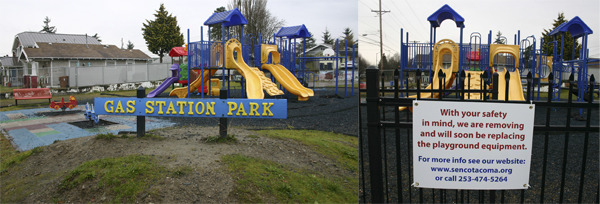It was less than four years ago that Tacoma City Councilmembers, Pierce County Councilmembers, and residents of Tacoma’s South End gathered at the corner of South 48th Street and South Park Avenue on a brisk October day to celebrate the opening of Gas Station Park: a 14,000 square foot space for children that included a new basketball court and playground equipment. The celebration capped years of hard work that turned the site of the former Franco’s Oil gas station — a plot of land with leaky tanks buried below 400 tons of contaminated soil, on which sat junked cars and garbage — into an urban oasis.
“It was kind of an eyesore in the area,” South End Neighborhood Council President Earl Brydson told the Tacoma Daily Index this week. “It sat there, gosh, a good 17 years.”
Beginning in 2001, the city and the neighborhood council partnered to change that ugly corner. They bought the land from Pierce County for $13,320, then spent nearly six years raising money through grants and donations to turn the property into a neighborhood park. The Environmental Protection Agency awarded a $100,000 grant to help remove the tanks. ExxonMobil contributed $85,000.
When it opened, many thought only better days were ahead for Gas Station Park.
If you visited the park today, however, you would be hard-pressed to find anyone there. A sign posted to the black, wrought-iron gate that wraps around the park does a good job of keeping people away: “With your safety in mind, we are removing and will soon be replacing the playground equipment.”
So what happened to Gas Station Park?
Last year, Metro Parks Tacoma and the city’s public works department completed a condition assessment report that showed a long list of issues: a playground equipment post was set in a bucket of concrete, creating a trip-and-fall hazard; kids careening down one of the slides landed on exposed rocks and earth; rusty bolts jutted out and threatened to snag children who ran by; and the shredded and recycled rubber used as playground fill wasn’t deep enough to protect kids from the hard surface, among other things.
According to Steve Potter, a certified playground safety inspector who wrote the four-page report, the play area’s surfacing “needs a lot of work. The protective surfacing is too shallow [and t]he hard earth directly underneath the surfacing is hazardous.” Potter also noted,” The designated play area is too small for the equipment. Signage is needed regarding adult supervision, installation over hard surfaces, manufacturer’s identification and age appropriateness. Head and neck entrapments need to be addressed. And some minor hardware issues need to be corrected.”
In October, Conor McCarthy, assistant division manager in Tacoma’s public works department, requested a second opinion and estimate for repairs from Gary Max, president of SiteLines, a supplier of park and playground equipment. Max, also a certified playground safety inspector, agreed with the assessment. “The issues here began with the choice of equipment, followed by a bad equipment installation, plus the use of inadequate and improper safety surfacing,” wrote Max. He recommended removing the playground equipment entirely and starting over again — a move that could cost between $40,000 and $45,000. “Investing further in this play equipment would not solve all of the problems and is not recommended.”
According to McCarthy and Jeff Jenkins, the city’s facilities division manager, an operations and maintenance agreement signed on Feb. 24, 2004, places the responsibilities of developing and maintaining the park on the neighborhood council. The city was not involved in selecting a playground equipment manufacturer, nor was it involved in the equipment installations, they said Thursday. McCarthy and Jenkins add that the city started looking into safety issues at the park after someone complained to City Hall.
On Jan. 7, public works staff and the South End Neighborhood Council met to discuss the findings. On Jan. 24, the neighborhood council told city staff it would like to keep the park and plans to remove the playground equipment some time in March or April, while also looking into the costs associated with making the necessary repairs, according to McCarthy, Jenkins, and the city manager’s report to city council dated Feb. 2. The report also noted the neighborhood council will work to find money to replace the playground equipment and will likely ask the city for support. “If [the neighborhood council] is unable to replace equipment, then ultimately they will plant grass, put up picnic tables, and make the park a picnic park,” the report notes.
“If we take everything out of there, it will be two or three years before we can get enough grant money,” Brydson told the Index this week.
On Tuesday, William Farrell, who lives near the park, urged city council to work with the neighborhood to repair the park. “I know that there’s a lot of people in the South End neighborhood who would love to volunteer their time and partner with the city to maintain that park,” said Farrell during the public comment portion of city council’s weekly meeting. “It would be a shame for the neighborhood to lose an asset like Gas Station Park for a lack of political will or funds.”
Brydson knows too well that closing the park won’t sit well with neighbors.
“Neighbors have contacted me,” he said. “They want that park to stay there. They don’t want the equipment pulled out and just have it sit there for two or three years just as grass. It’s a nice little park.”








